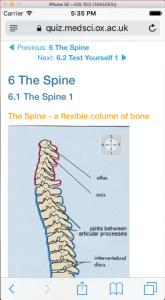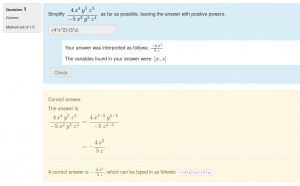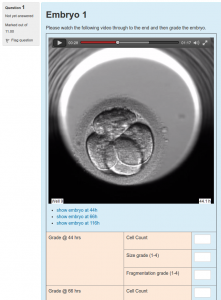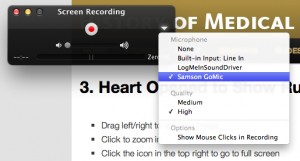An attempt to collect together some understandable documentation on how to use the Sakai (@Oxford Sakai=WebLearn) Entity Broker (EB) methods in the face of continued frustration with Sakai documentation accessed via /direct/describe (@Oxford https://www.weblearn.ox.ac.uk/direct/describe).
I’m only going to cover methods to return JSON as that’s all we ever use and am not bothering to describe the format of the returned JSON as it’s easier just to look at what’s returned in the browser.
- Announcement
- Assignment
- Content
- Forums (including Topic, Thread and Message)
- Group
- Lesson
- Lessons
- Membership
- Polls
- Portal-hierarchy
- User
announcement
Gets the announcements for a site for the logged in user.
/direct/announcement/site/siteId.json
e.g @Oxford
https://weblearn.ox.ac.uk/direct/announcement/site/d1506490-a468-46ca-a915-417d9d11be2f.json
assignment
Gets the assignments for a site for the logged in user.
/direct/assignment/site/siteId.json
e.g @Oxford
https://weblearn.ox.ac.uk/direct/assignment/site/d1506490-a468-46ca-a915-417d9d11be2f.json
content
Gets the contents of the Resources tool.
/direct/content/resources/group/siteId[/subFolderPath].json[?depth=noOfSteps]
where:
- subFolderPath (optional) is the path a subfolder (path relative to root of Resources)
- noOfSteps (optional) is the no of ‘layers’ of content to return (seems to have a maximum value of 3?). If not specified defaults to 1.
e.g @Oxford
https://weblearn.ox.ac.uk/direct/content/resources/group/1e969f60-9ebf-48b7-bb0f-54f598de05da/Online%20assessments%20documents.json?depth=2
forums (including topic, thread and message)
Get all fora for a site:
/direct/forums/site/siteId.json
Get all topics for a forum:
/direct/forums/site/siteId/forum/forumId.json
Get all conversations for a topic:
/direct/forums/site/siteId/forum/forumId/topic/topicId.json
Get a fully populated conversation or message. This retrieves the message tree from the specified message downwards. If the messsageId is the top level message in a conversation, the entire conversation is returned:
/direct/forums/site/siteId/forum/forumId/topic/topicId/message/messsageId .json
…and to link directly to individual parts of forums:
For direct forum link url is :
/portal/hierarchytool/siteId/discussionForum/forum/dfForumDirect.jsf?forumId=forumId
Direct forum_topic link is :
/portal/hierarchytool/siteId/discussionForum/message/dfAllMessagesDirect.jsf?topicId=topicId
Direct link to individual message is :
/portal/hierarchytool/siteId/discussionForum/message/dfViewMessageDirect.jsf?messageId=messsageId &topicId=topicId&forumId=forumId
group
Get the membership of a group.
/direct/membership/group/groupId.json
whee groupId can be found by looking at the address of the page when editing a group in Siet Info | Manage Subgroups – may also be possible to find by name with /direct/site methods?
e.g @Oxford
https://weblearn.ox.ac.uk/direct/membership/group/8513fad8-656f-4265-9573-f00b8a781d02.json
lesson
Get the contents of a lesson.
/direct/lessons/lesson/lessonId.json
where lessonId is the id or entityId returned by direct/lessons (above)
e.g @Oxford
https://weblearn.ox.ac.uk/direct/lessons/lesson/35538.json
lessons
Get a list of the lessons in a site.
/direct/lessons/site/siteId.json
e.g @Oxford
https://weblearn.ox.ac.uk/direct/lessons/site/1e969f60-9ebf-48b7-bb0f-54f598de05da.json
Note that, in Sakai 11 at Oxford anyway, the lessons EB method will not currently (03/10/16) return lessons to access users – only those with elevated rights e.g for the same call:
As a maintainer:
{"entityPrefix": "lessons", "lessons_collection": [
{
"contentsURL": "https:\/\/weblearn.ox.ac.uk\/direct\/lessons\/lesson\/78676",
"gradebookPoints": null,
"id": 78676,
"lessonTitle": "Module 1",
"releaseDate": null,
"hidden": false,
"entityReference": "\/lessons\/78676",
"entityURL": "https:\/\/weblearn.ox.ac.uk\/direct\/lessons\/78676",
"entityId": "78676"
}
]}
As an access user:
{"entityPrefix": "lessons", "lessons_collection": [
]}
membership
Get information about membership of a given user in a given site
/direct/membership/userId::site:siteId.json
where:
- userId is the id (Sakai’s internal reference) of user about which you want info (obtainable for logged in user from user/current.json as below)
- siteId is the Sakai siteId.
e.g @Oxford
https://weblearn.ox.ac.uk/direct/membership/d00ca345-4e31-485c-00e9-0fc880da2dc0::site:d1506490-a468-46ca-a915-417d9d11be2f.json
polls
Can’t find any way to get a list of polls for a site!
Get poll text and options
/direct/polls/pollId/poll-view.json?includeOptions=true
where:
- pollId is the id (Sakai’s internal reference) of the poll. This is most easily obtained by hovering over the poll name in the edit view and picking out the number(!)
- includeOptions (boolean) specifies whether to also return the options for the poll and;
- includeVotes (boolean) specifies whether to also return the votes cast
e.g @Oxford
https://weblearn.ox.ac.uk/direct/polls/pollId/poll-view.json?includeOptions=true
portal-hierarchy (maybe only @Oxford?)
Provides a list of all the sites (to which the user has access) under a given site – one level down only.
/direct/portal-hierarchy/site.json?portalpath=pathFromRoot
e.g @Oxford
https://weblearn.ox.ac.uk/direct/portal-hierarchy/site.json?portalpath=/medsci
user
Information about the logged-in user – mainly used to get interal Sakai id for use in other methods.
/direct/user/current.json
e.g @Oxford
https://weblearn.ox.ac.uk/direct/user/current.json
more..
I’ll try to remember to add to these as I use them.







